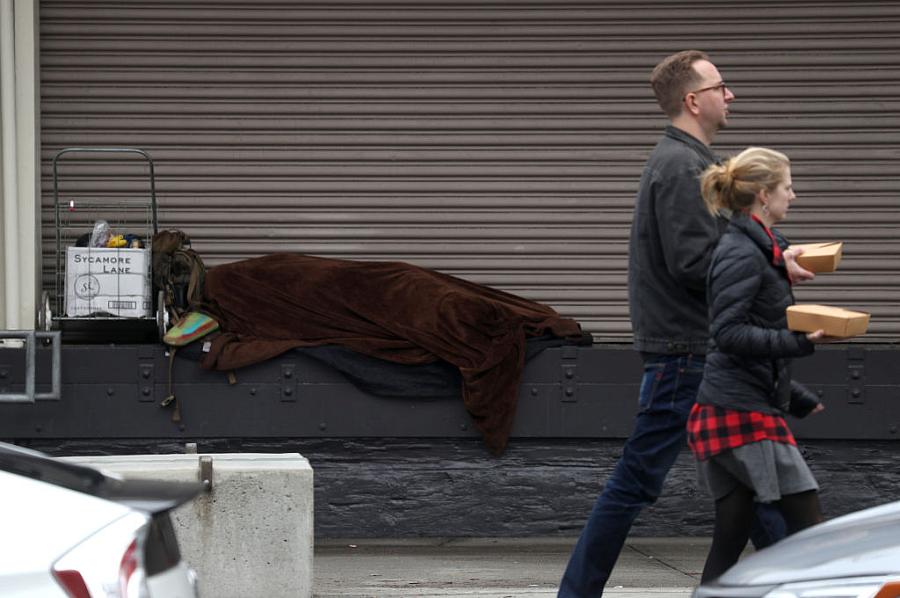This San Francisco agency is flush with cash. Will it spend it wisely to address the homelessness crisis?

(Photo by Justin Sullivan/Getty Images)
The pandemic had a silver lining of sorts in San Francisco. It showed that the city’s agencies – including one charged with providing services to unhoused residents — could shift personnel and resources to quickly meet immediate public health needs.
This happened when the city rented hotel rooms — shuttered to tourism by COVID — to house and treat people experiencing homelessness who tested positive for the coronavirus. Most — 81% — were successfully treated and required no hospitalization. This had the multiple benefits of reducing community spread, keeping emergency rooms and ICUs below capacity, and showing how the combination of housing and services is an effective health care remedy.
Now the issue is whether the city’s Department of Homelessness and Supportive Housing (HSH) can move with the same sense of urgency and care in tackling the ongoing homelessness crisis on its streets. The department, chronically understaffed since its inception, has endured a major upheaval in its leadership ranks over the last eight months. All this comes as its budget has grown to an unprecedented level of $1.2 billion, thanks to federal and state funds to help the city recover from the public health emergency.
Having a lot of money to spend may sound like a great problem to have, given that the HSH started out five years ago with a budget that was a tiny fraction of what it is today. But the department has to overcome several operational issues — laid bare in a scathing audit issued in August 2020 — to meet the challenges ahead.
The biggest revelation in the audit? “The department doesn’t sufficiently monitor provider contracts to ensure that service goals are met,” the city’s legislative analyst wrote.
This is troubling as HSH depends entirely on the nonprofit service providers to administer and run all of its shelter, housing, and programs. In the current fiscal year, the department devotes just 5.3% of its budget to in-house salaries and benefits. That’s very low compared to the citywide average of 45%, according to the city controller’s office.
This dependency on nonprofit providers means there needs to be follow up, particularly in a time with so much money available and when HSH was given a green light of sorts 2019 to issue contracts for services and housing without any bidding process, owing to a homelessness emergency.
The no-bid resolution was enacted just as the city completed its last point-in-time count, which found 8,035 unhoused people in San Francisco. The provision is intended to sunset either in March of 2024 or when the point-in-time count goes down to 5,350. Most providers and advocates expect this number to be higher when the next scheduled census takes place in January 2022.
By budget, HSH is the largest city department without any formal oversight commission. With so much money available and little supervision over spending, it’s important to look into the spending priorities and patterns of the department to see where all this money is going.
Who are the top recipients of department funds? Are providers delivering on their contracts? Has the no-bid contract era affected the amounts of contracts and who receives them? Has any one organization or set of organizations benefited more from contracts awarded in the no-bid era? Is someone checking up on the no-bid contracts to ensure the services are delivered?
These questions are among those that will guide my reporting, which will look at the department’s spending priorities and whether these match the goals set out by city officials and the needs of people on the streets.
The financial questions come at a time when the department is pivoting to focus more on equity. The new director, Shireen McSpadden, has placed a big emphasis on ensuring that Black people, who are disproportionately represented in the city’s count of unhoused people, get access to more benefits commensurate with their size in the population.
In the last month, the department hired a chief equity officer, the first. It is also in the process of revamping its coordinated entry system, including the underlying technology as well as adding more sites for people to sit for interviews to be used to assess what resources they need and can access.
The addition of what are called access sites means potentially adding on new service providers. It is yet uncertain whether these will simply add on or take the place of other providers, but McSpadden says there needs to be better representation of people of color in terms of heading up organizations that are providing services.
Since all of the emphasis is on ensuring equity, what has the process for getting people access to housing looked like in the past?
San Francisco is only three years into using coordinated entry, and as this is the gateway to supportive housing, who has been receiving access to this resource? Those who don’t get housing receive what’s called “problem solving,” which can include rental subsidies or a bus ticket to extended family. How equitable has this process been?
Like other cities, San Francisco is striving to make amends for past practices like redlining and urban renewal that displaced the city’s black community. How will a revamped coordinated entry system and a push for more equity address these issues?
I plan to dig into the underlying data to see where we’ve been and look forward to what may be ahead through the department’s spending priorities. But a bigger part of this will be looking at the very people who hope to get off the streets and the newer providers being brought on to serve them.

